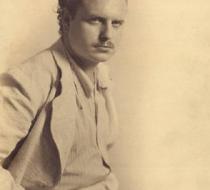Josep Renau Berenguer (Valencia, Spain, 1907 – Berlin, Germany, 1982): Art and political engagement 1 Favorite
Josep Renau Berenguer was a Spanish painter, photomontager, muralist and communist militant.
Renau was the son of an Art teacher. Due to his father’s low income, he had to work various jobs during his youth and teenage years to maintain a middle class position.
Since he was very young he showed an innate talent for painting, but he also learnt different techniques, like lithography and photomontage, from his different jobs in the graphic industries. From 1918 and 1925 he studied Fine Arts in Valencia. During this period he won his first award. Meanwhile, he was working as a photographer and as a muralist. His film posters were celebrated internationally.
In 1931 he joined the Spanish Communist Party, and also founded the Union of Proletariat Writers and Artists. In his work from this period he criticizes bourgeois and right wing values, but especially he will attack fascism, an ideology that was blooming all around Europe and also in Spain.
He will create his most famous works during the Spanish Civil War, when he produced posters supporting the Republican regime. By this time he publishes his book La Función Social del Cartel Publicitario (The Social Fuction of the Advertising Poster), where he encouraged artists to use their work as a weapon against fascism.
In 1936, immediately after the war started, he was named General Director of Fine Arts. From this position, he contacted Pablo Picasso and requested him to paint the Guernica in 1937 for the International Exhibition of Paris. He also contributed to the Spanish selection for this exhibition with a series of photomontages. He was also the one who decided to move part of the collection of the Prado Museum to Valencia, and eventually to Switzerland, to protect it from the bombings that were devastating Madrid.
When the war ended, and the francoist dictatorship started, he managed to escape to France, when he was confined in the concentration camp of Argeles-sur-Mer. He finally got a permission to leave France and move to Mexico, where he worked for exiled Spanish magazines.
In 1958 he left Mexico and moved to the German Democratic Republic, specifically to East Berlin. There, he kept producing photomontages.
He was able to go back to Spain in 1976, but he decided to stay in Berlin and only travel to Spain on occasion. He died in Berlin in 1982.
As it was mentioned above, he also wrote about art and politics. In one of his most interesting pieces, the book Arte contra las Élites (Art against the Elites), he offered a counterpoint for Walter Benjamin’s thesis in The Work of Art in the Era of the Mechanical Reproduction, claiming that the fact that the original work of art loses its value, combined with the disappearance of the distance between the audience and the work of art, enables a true democratic appropriation of the work of art as opposed to capitalist, museum-like appropriation.








